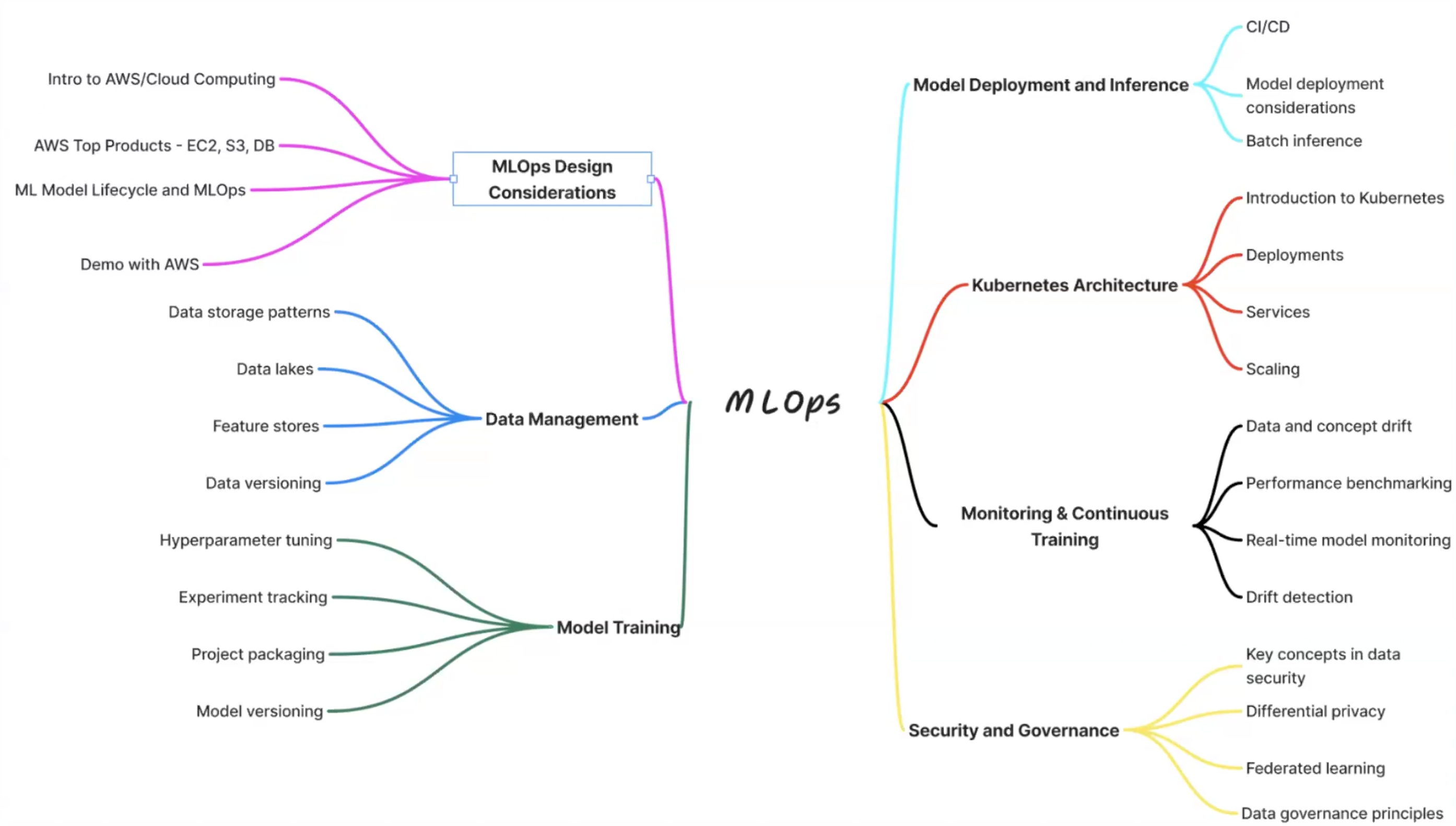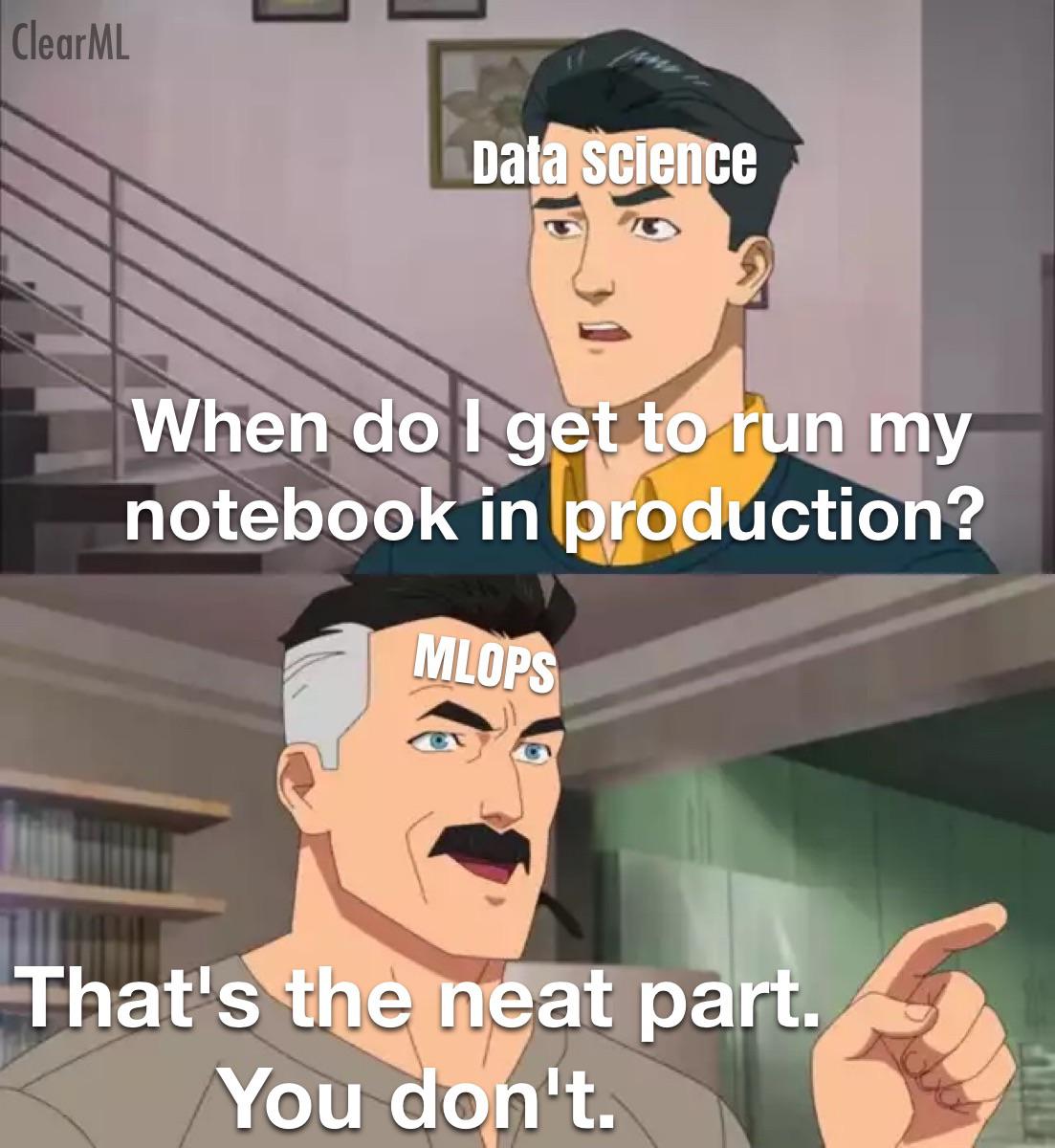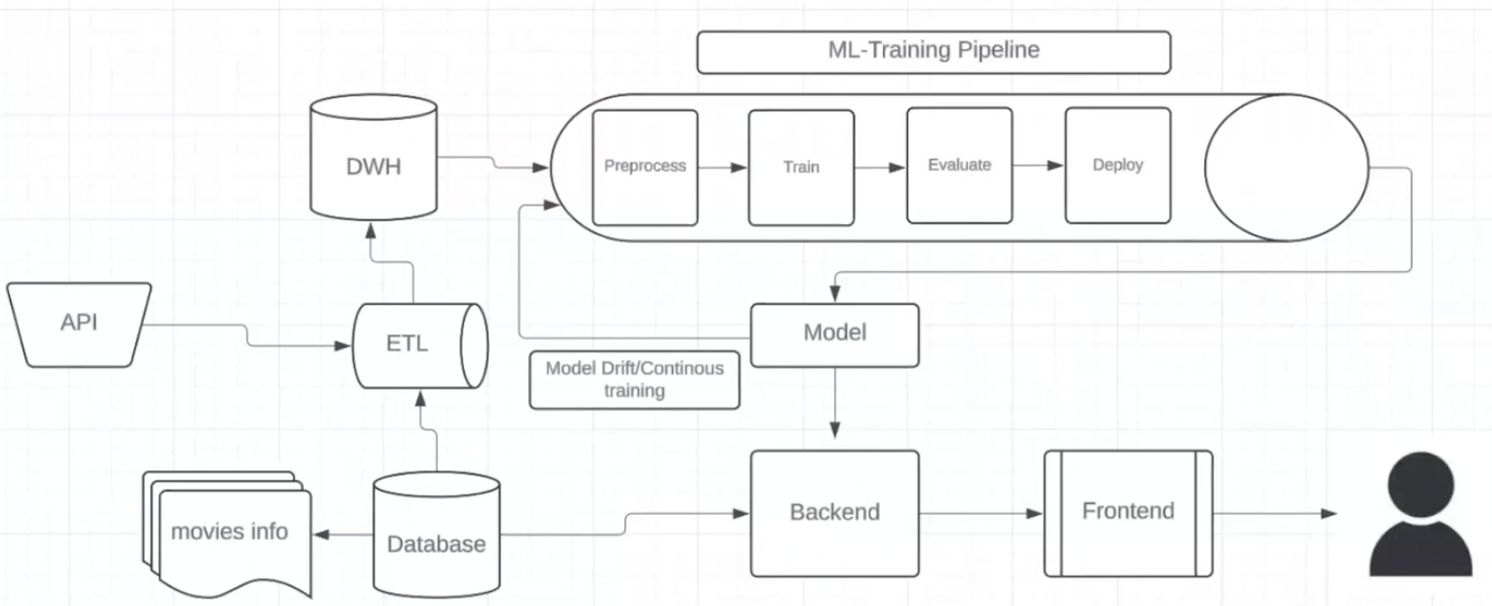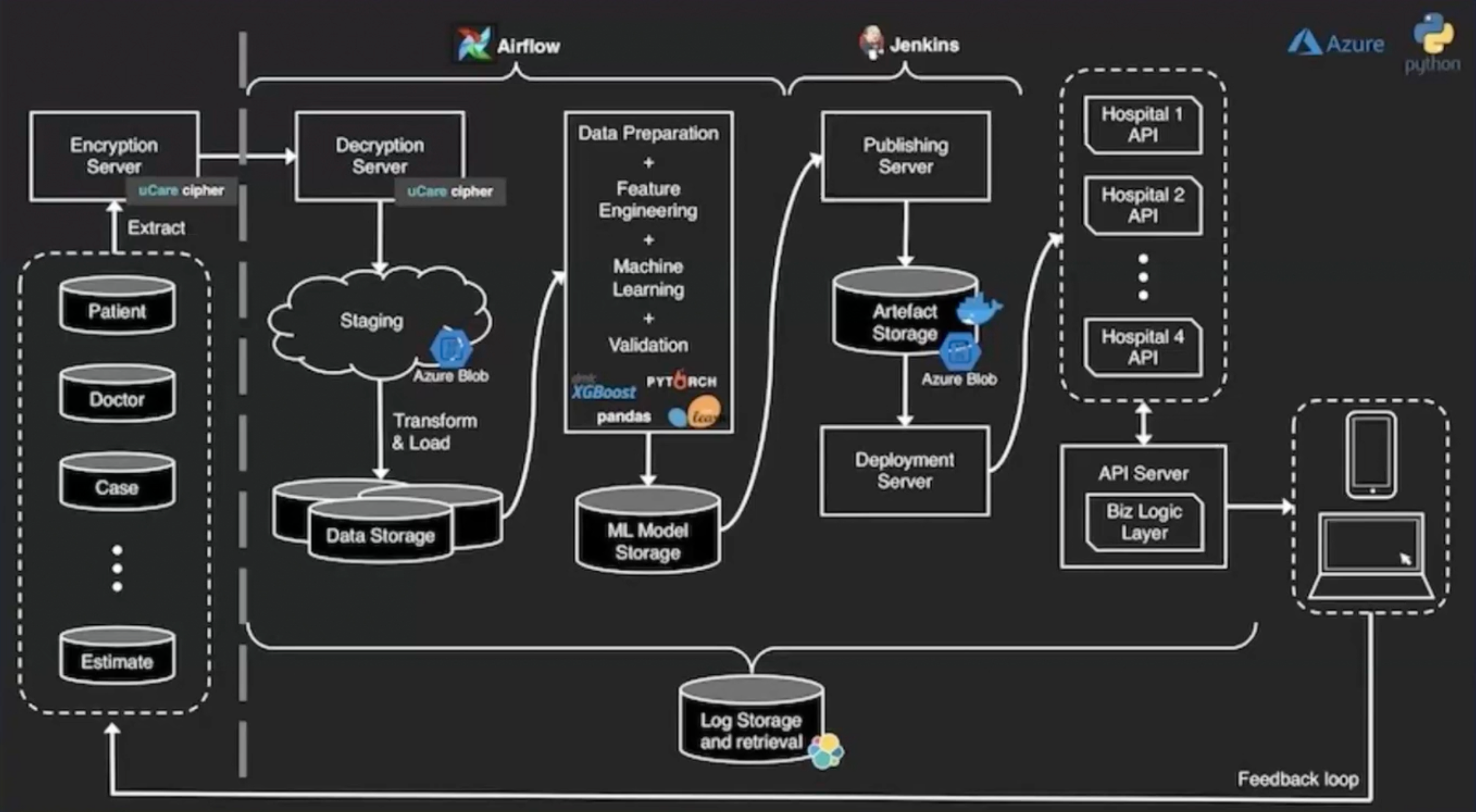MLOps Design Considerations
Agenda
- Introduction and Overview of MLOps
- Introduction to AWS and Cloud Computing
- Top Products Demo in AWS
- Model Monitoring
- ML Solutions Available in AWS
Introduction to MLOps
MLOps Mind Map

- Key Components:
- Data Management
- Model Training
- Model Deployment
- Kubernetes
- Monitoring and Logging
- Security and Governance
- Roles and Pathways:
- MLOps engineers can specialize in various areas.
- MLOps is essential for integrating ML products into existing ecosystems.
- Career Insights:
- MLOps is a rapidly growing field due to the rise of AI as a service.
- Skills in data management, security, and model deployment are highly sought after.
Why Not Run Notebooks in Production?

- Version Control:
- Difficult to track changes and perform merges.
- The cell-based structure complicates versioning.
- Execution Order:
- Out-of-order execution leads to unpredictability.
- Variables can be defined in any order, causing inconsistent results.
- Modular Code:
- Notebooks often lack modularity, making code reuse challenging.
- Testing and Code Reviews:
- Difficult to implement testing frameworks.
- Challenging to perform thorough code reviews.
- Deployment Complexity:
- Not designed for production environments.
- Issues with packaging and deploying notebooks.
- Environment Consistency:
- Dependency management is complex.
- Environments may be inconsistent between development and production.
- Orchestration and Logging:
- Difficult to orchestrate workflows.
- Limited logging capabilities for monitoring.
- Security Concerns:
- Notebooks may expose sensitive data.
- Lack proper authentication and authorization mechanisms.
Importance of MLOps
- Consistency and Reliability:
- Ensures predictable model behavior in production.
- Example: Uber Eats delivery time predictions must be accurate.
- Reproducibility:
- Ability to reproduce results across different environments.
- Scaling from POC to Production:
- Transitioning from proof-of-concept to scalable, maintainable systems.
- End-to-End Management:
- MLOps covers the entire lifecycle from data ingestion to model deployment.
Netflix Movie Recommender Example
Problem Statement
- Goal: Develop a movie recommender system for Netflix.
- Approach:
- Scenario 1: Recommend movies based on ratings (Rule-Based System).
- Scenario 2: Provide personalized recommendations (ML-Based System).
Scenario 1: Rule-Based System
Architecture Diagram

- Components:
- Database: Stores all movie information.
- Model: Business rules (e.g., movies rated 4 stars or above).
- Backend and Frontend: User interface for displaying recommendations.
Characteristics
- Static System:
- Provides the same recommendations to all users.
- Simplicity:
- Easier to implement and maintain.
- Limitations:
- Lacks personalization.
- Does not adapt to individual user preferences.
- Example Rules:
- Top 10 highest-rated movies.
- Movies rated 4 stars or higher, sorted alphabetically.
DevOps Perspective
- Focus: Software Development Lifecycle (SDLC).
- Maintenance: Stable, predictable systems.
- Updates: Manual rule changes as needed.
Scenario 2: ML-Based System
Architecture Diagram

- Components:
- Data Sources:
- Movie Database: Movie details and ratings.
- User Data API: User interactions and preferences.
- Data Warehouse:
- Combines movie and user data for comprehensive analysis.
- ML Training Pipeline:
- Data Preprocessing: Clean and prepare data.
- Model Training: Develop ML models.
- Evaluation: Assess model performance.
- Deployment: Move models to production.
- Model Continuous Training:
- Regular updates to models with new data.
- Addresses model drift.
- Backend and Frontend:
- Interfaces for user interaction.
Characteristics
- Dynamic System:
- Provides personalized recommendations for each user.
- Complexity:
- Multiple data sources and types (CSV, JSON, text).
- More components and moving parts.
- Continuous Improvement:
- Models adapt over time based on new data.
- Reflects changing user behavior (e.g., seasonal interests).
- Data Types:
- Structured Data: CSV files.
- Semi-Structured Data: JSON files.
- Unstructured Data: Text and images (JPEGs).
MLOps Perspective
- Challenges:
- Managing data ingestion from various sources.
- Ensuring data quality and consistency.
- Orchestrating complex workflows.
- Benefits:
- Enhanced user experience through personalization.
- Ability to adapt to new trends and preferences.
- Key Processes:
- ETL (Extract, Transform, Load): Data preparation steps.
- Experimentation: Using notebooks for model development.
- Production Deployment: Moving models into production environments.
Comparing DevOps and MLOps
DevOps
- Definition: Practices combining software development (Dev) and IT operations (Ops).
- Focus:
- Software release management.
- Infrastructure provisioning.
- Continuous Integration/Continuous Deployment (CI/CD).
- Characteristics:
- Stable, predictable systems.
- Manual updates to rules or code.
MLOps
- Definition: Extension of DevOps principles to include Machine Learning workflows.
- Focus:
- Managing the ML lifecycle.
- Data management and versioning.
- Model deployment and monitoring.
- Characteristics:
- Dynamic, data-driven systems.
- Continuous model training and deployment.
- Handles model drift and data changes.
Key Differences
- Data Complexity:
- MLOps handles large, diverse datasets.
- Model Lifecycle:
- Continuous training and evaluation in MLOps.
- System Behavior:
- MLOps systems are adaptive; DevOps systems are more static.
- Maintenance:
- MLOps requires monitoring model performance over time.
Key Takeaways
- Increased Complexity:
- MLOps introduces new components (e.g., data pipelines, training pipelines).
- Continuous Updates:
- Models require regular retraining with new data.
- ABU (Always Be Updating):
- Emphasis on keeping models current and relevant.
- Adaptability:
- Systems can adjust to user behavior and trends without manual intervention.
Deploying Models Without APIs
- Question: How are models deployed in systems where APIs cannot be used, such as payment fraud detection?
- Answer:
- On-Edge Deployment:
- Deploy models directly on the device or system.
- Microservices:
- Wrap models as microservices within the application.
- Unified Interface Engines:
- Use tools like TensorFlow Serving, TorchServe, or ONNX Runtime.
- SDKs and Libraries:
- Integrate models using software development kits.
- Batch Processing:
- Utilize batch jobs for non-real-time inference.
MLOps System Design
Deployment Strategies
Deploying Models Without APIs
- Direct Deployment:
- Models can be deployed directly to end devices.
- Example: Fraud detection systems where APIs cannot be used.
- Library Deployment:
- Models packaged as libraries for integration.
- MLOps Flexibility:
- MLOps engineers craft deployment solutions that meet specific requirements.
- Deployment types differ significantly from static deployments in DevOps.
Continuous Improvement in MLOps
- No Perfect Model:
- ML models require continuous improvement; there is no “perfect” model.
- User preferences change over time (e.g., movies watched in October vs. December).
- Importance of External Data:
- ML models should not rely solely on static databases.
- Continuous data ingestion is necessary for model relevance.
Building and Deploying Models
- Building an Image and Deploying:
- Containerization:
- Use Docker to create a self-contained executable image.
- Dockerfile defines the environment and dependencies.
- Deployment:
- Use orchestration platforms like Kubernetes.
- Steps:
- Containerize the model with Docker.
- Deploy the Docker image using Kubernetes.
Responsibilities in MLOps
- Execution on Edge Devices:
- Split Responsibility:
- MLOps engineers monitor, update, and maintain models.
- Engineering teams handle execution and testing on devices.
System Design in MLOps
High-Level Overview

- Complex Pipelines:
- MLOps involves orchestrating complex ML pipelines.
- Example: Machine learning pipeline in a healthcare setting.
- Components:
- Data Extraction:
- Multiple data inputs (e.g., encryption servers, data sources).
- Workflow Orchestration:
- Tools like Airflow and Jenkins automate the pipeline.
- Model Training:
- Use tools like XGBoost, PyTorch, Pandas.
- Deployment:
- Serving inferences to downstream systems.
- MLOps Role:
- Responsible for orchestration, data management, and serving predictions.
- Acts as a support system for ML experiences and engineering.
- Common Tools:
- Cloud Platforms:
- Infrastructure as Code:
- Tools for automating infrastructure provisioning.
- CI/CD:
- Monitoring and Logging:
- Maturity of MLOps:
- MLOps is a relatively new field.
- Terminology and tools may vary across companies.
ETL and Feature Engineering
- ETL (Extract, Transform, Load):
- Typically managed by data engineering teams.
- Not usually a direct responsibility of MLOps engineers.
- Feature Engineering:
- Part of the modeling process.
- Decisions made by ML engineering teams.
Standardization in MLOps
- Goal:
- Provide technologies, processes, and standardization.
- Minimize disruptions and ensure reliable customer experiences.
MLOps Lifecycle
Phases and Activities
- ML Development:
- Experimentation and prototyping of models.
- Output: Formalized training procedures.
- Training Operationalization:
- Creating robust training pipelines based on ML engineers’ requirements.
- Continuous Training:
- Regularly updating models with new data.
- Ensures models remain relevant over time.
- Model Deployment:
- Deploying updated models into production environments.
- Prediction Serving:
- Serving predictions to applications and users.
- Continuous Monitoring:
- Monitoring model performance and detecting issues.
- Triggers retraining if performance degrades.
Data and Model Management
- Data Versioning:
- Partitioning data by time, region, or user.
- Associates specific data versions with model versions.
- Example:
- V1 Data: October 2024 (Halloween model).
- V2 Data: December 2024 (Christmas model).
- Importance:
- Ensures consistency between data and models.
- Facilitates retraining and model updates.
Differences Between ML Models
Classic ML vs. Deep Learning vs. RAG
- Classic Machine Learning:
- Steps:
- Collect Data
- Preprocess Data
- Feature Engineering
- Model Selection and Training
- Evaluation
- Deployment
- Characteristics:
- Manual feature engineering.
- Less computationally intensive.
- Deep Learning:
- Steps:
- Collect Data
- Preprocess Data
- Automatic Feature Extraction
- Model Training
- Evaluation
- Deployment
- Characteristics:
- Uses CNNs, RNNs, Transformers.
- Automatic feature extraction.
- More resource-intensive.
- Requires careful resource management in MLOps.
- Retrieval-Augmented Generation (RAG):
- Steps:
- Retrieve Relevant Information
- Use APIs, vector databases (e.g., BM25, DPR).
- Embed Data
- Process with Large Language Models (LLMs)
- Generate Output
- Characteristics:
- Combines multiple models and technologies.
- MLOps focuses on orchestrating components rather than owning models.
- Detecting Model Degradation:
- Data Drift Detection:
- Monitoring changes in data distribution.
- Model Drift Detection:
- Evaluating model performance on holdout test sets over time.
- Proxy Metrics:
- Confidence levels, anomaly detection.
- Feedback Loops:
- Incorporating manual labeling or expert review when necessary.
- Categories:
- All-in-One Platforms:
- Data Sources and Storage:
- Data warehouses, data lakes.
- Versioning and Labeling:
- Tools for data versioning and annotation.
- Training and Deployment:
- Various tools based on organizational needs.
- Recommendation:
- Focus on tools used by your organization.
- Build proficiency in relevant tools for practical application.
DevOps and MLOps Integration
DevOps Loop
- Phases:
- Plan → Code → Build → Test → Release → Operate → Monitor → Plan (continuous cycle).
- Purpose:
- Combines development and operations for faster delivery.
- Automates building, testing, and releasing software.
CI/CD in DevOps
- Continuous Integration (CI):
- Automates code integration and testing.
- Continuous Deployment (CD):
- Automates software deployment to production.
- Benefits:
- Faster iteration.
- Improved stability.
- Collaboration across development, operations, and QA.
CI/CD/CT in MLOps
- Adds Continuous Training (CT):
- Regularly retrains models with new data.
- Changes in CI/CD:
- CI:
- Validates not just code but also data, schemas, and models.
- CD:
- Focuses on deploying ML training pipelines and services.
- Use Case:
- Predicting delivery times for Uber Eats.
- Factors Considered:
- Order preparation time.
- Driver availability and location.
- Traffic conditions.
- Scale:
- Millions of users and daily inferences.
- MLOps Challenges:
- Requires robust infrastructure to handle real-time predictions.
- Continuous model updates to reflect changing conditions.
Amazon SageMaker
- Overview:
- All-in-one MLOps platform by AWS.
- Covers the entire ML lifecycle from development to deployment.
- Features:
- Model development tools.
- Training and tuning capabilities.
- Deployment and hosting services.
- Ideal For:
- Small to medium businesses.
- Organizations seeking quick ML capabilities without building from scratch.





